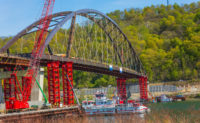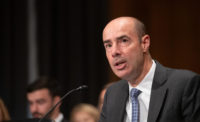Transit Infrastructure
Senate Panel Starts Work on Transit Reauthorization
Preliminary work has begun in the Senate on the transit portion of a multi-year surface transportation bill, the construction industry’s top legislative priority.
The Senate banking committee, which has jurisdiction over transit, held a hearing on Feb. 25 on the not-yet-drafted legislation, listening to testimony from officials from the nation's transit systems, including small urban, rural and specialized agencies, as well as state transportation departments, business and organized labor groups. [View video of hearing here.]
Banking committee Chairman Mike Crapo (R-Idaho) didn’t say when the panel’s transit measure might be unveiled, but he did say, “We want to get this right. And we want to get it done.” A committee spokesperson said she had no further specifics on the timetable.
One strong theme during the hearing was support for transit in rural areas. Crapo said that “we really need to expand our focus on rural areas as we deal with our transit issues in this country.”
There also were calls for increased overall transit funding.
Seeking higher funding
Patrick McKenna, director of the Missouri Dept. of Transportation and president of the American Association of State Highway and Transportation Officials, said, “While states are willing to commit more of their funds for public transit, they need to see a significant growth in federal investment in order to improve our nation’s public transportation systems.”
Paul Skoutelas, American Public Transportation Association (APTA) president and chief executive officer, said his group would like to see the new bill provide $145 billion over six years for transit.
That compares with President Trump’s recent proposal of $155 billion, but over 10 years, and the $105 billion over five years in the infrastructure “framework” that House Democrats released in January.
The current transportation authorization, the 2015 Fixing America’s Surface Transportation, or FAST, Act authorized $60.9 billion for transit, over five years, according to a summary from the American Road & Transportation Builders Association.
The FAST Act expires on Sept. 30 of this year.
In July, the Senate Environment and Public Works Committee cleared one of the key elements of the hoped-for transportation bill, a $287-billion, five-year highway measure.
But there has been no action yet from the Finance Committee, the Senate panel responsible for finding the additional revenue needed to fund the transportation package.
But the banking panel's hearing was a signal that work is beginning on the transit title. [View video of hearing here.]
Highway Trust Fund
Echoing many other lawmakers, and state and industry officials have long been saying, Crapo, and the committee’s top Democrat, Sherrod Brown (Ohio), noted that new revenue needs to be found to shore up the ailing Highway Trust Fund.
Crapo recalled that to meet the funding levels in the FAST Act, Congress had to transfer $52.8 billion from the general fund to the trust fund for highways aand an additional $18.1 billion for transit.
The major sticking point for the FAST Act's successor is where to find the revenue to bolster the trust fund. McKenna said in his prepared testimony for the hearing that lawmakers would have to find ways to raise about $100 billion for the new bill (assuming it's a six-year measure), if it is to just continue the FAST Act levels, plus an increase for inflation.
Skoutelas said APTA strongly supports the U.S. Chamber of Commerce's proposal to raise revenue by increasing the federal motor fuels tax by 25 cents per gallon over five years.
Crapo didn’t endorse any specific revenue-raisers. But he bluntly ruled out one set of revenue sources, saying that Fannie Mae and Freddie Mac guarantee fees, Federal Reserve dividends and the Fed’s surplus funds “should not be used as a piggybank.”
Rural focus
Crapo called transit "a huge issue" in rural areas.
APTA's Skoutelas agreed, saying rural transit is “critically important,” and noting that APTA’s reauthorization proposal includes doubling funding for transit in rural locales.
He also said the organization is calling for increasing the bus and bus facilities program’s share of overall Federal Transit Administration capital dollars back to 20%. Skoutelas noted that the bus/bus facilities category is particularly helpful for rural transit agencies. He said in his prepared testimony that that bus category had fallen below that 20% level in recent transportation authorization laws.
McKenna said Missouri would like to see the federal share for transit capital assistance programs raised to 90%, from about 80% now. He added that it is difficult for rural and specialized transit agencies to come up with the 20% local share for new transit vehicles.




